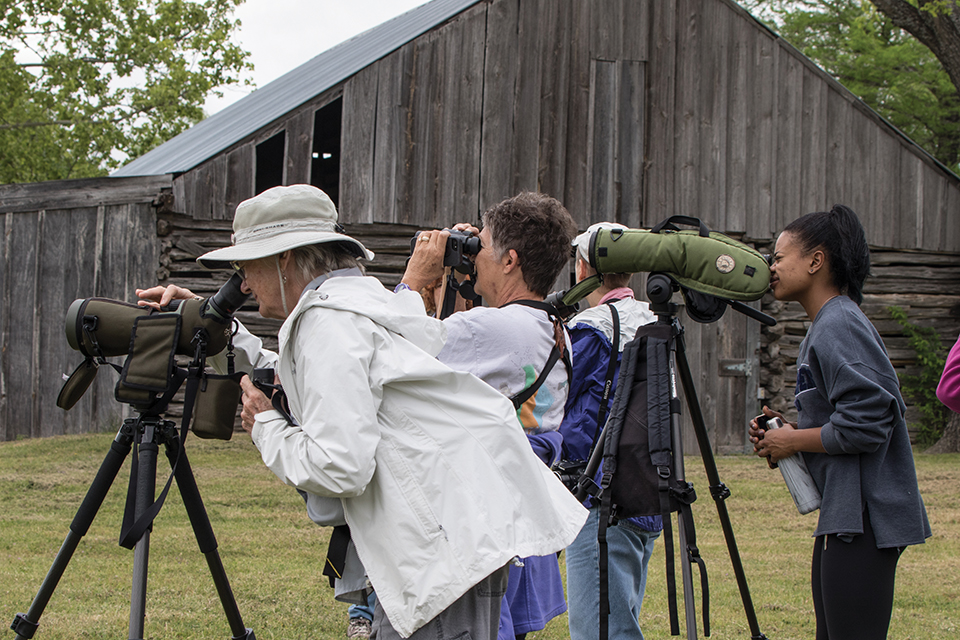Fly Something New

On a misty Saturday morning, 32 muddy-shoed people stared into the Mary Moore Searight Metropolitan Park woods at nothing. That’s because they weren’t looking, but listening.
The group was on a beginner bird walk hosted by Travis Audubon, Austin’s oldest conservation organization. Their aim is to protect and advocate for Austin’s land and wildlife, especially through birdwatching, according to Caley Zuzula, program and education coordinator.
The walk was led by George Kerr, a veteran birder who could quickly identify the species of a bird that may have looked, to a less experienced eye, like a small black dot shooting across the sky.

“When you start to learn stuff, you begin to realize that there’s all this world out here that you haven’t really been paying attention to,” Kerr says. “The more you learn, the more fun it is.”
Kerr told the group to listen for the “loud, slur whistle” of Northern Cardinals and the typewriter-like click of a Ruby-crowned Kinglet. Even with no birds in sight, he encouraged them to take in their surroundings.
“Birders don’t just look at birds, we’re looking at everything,” Kerr says, identifying some flora along the trail path.
The morning’s walk was free and open to people of all ages and skill levels. Mountain City resident Karen Davis joined the crowd with her 8-year-old grandson, Colton.
A newcomer to birding, Davis says she wanted to learn more about different bird species after setting up feeders in her yard. Colton’s reason for early-morning birding was simple.
“I wanted to come with you,” Colton says to his grandma.
Davis says she often takes Colton and her other grandkids outdoors, whether it be camping, hiking or, most recently, birdwatching.
“Sometimes we go through the A, B, Cs, and look for things that start with the letters,” Davis says. “It would be nice if we knew about birds because we could add birds to our list of things to be looking for.”

Travis Audubon offers various free bird walks like this one each month, as well as paid classes for more advanced birding experiences. Zuzula says when people get involved in birding, they can also gain a new appreciation for the environment.
“When they learn more about birds through us, go birding with us, they realize that there are more birds than they even realized,” Zuzula says. “In that way, people get inspired to learn more about their habitat and want to learn more about how to protect them.”
The organization — currently made up of about 1,200 members — takes advantage of Austin’s parks and green spaces, Zuzula says. Austin is home to unique bird species such as the Golden-cheeked Warbler, which only breeds in the Texas Hill Country.
Zuzula compares birding to the mobile game, Pokémon GO, which encouraged people from around the world to go outdoors and look for virtual creatures when it was released in 2016.
“With birding, it’s like real-life Pokémon,” Zuzula says. “It’s really really cool to walk around a park and look for these different types of birds. It really is like a fun game.”
Travis Audubon offers classes for bird and butterfly identification, as well as sessions for birding-related activities such as photography. The walks are led by volunteers, and are available to participants of various skill and experience levels, Zuzula says.

Virginia Rose, who leads another free walk through Travis Audubon, knows that birding isn’t all “bushwhacking” and combing through woods looking for birds. She has identified 35 birdwatching sites in Austin with pavement fit for mobility-challenged birders, and she utilizes them on her monthly walk, Birdability.
Rose has used a wheelchair since a horseback riding accident at the age of 14. She started birding with Travis Audubon in 2003, and says she instantly fell in love with the hobby.
“Not one field trip leader said no to me,” Rose says. “I just sort of threw myself on the mercy of every field trip, and just assumed that I could do it, and assumed that they wouldn’t mind.”
After taking classes, Rose began leading a monthly beginner bird walk. She continued instructing for seven years, all the while compiling a list of accessible places to bird in Austin.
Rose started her initiative, Birdability, last April, and has lead an accessible bird walk through it each month since. She’s trying to fill a niche for people who feel left out of the other, more able-bodied walking world with birding.
“I think people in wheelchairs and walkers feel unable to experience the outdoors, and I think it’s because they haven’t been shown what they can do,” Rose says. “I’m sure that after they go with me a couple times, that they’ll be hooked on it.”
While Rose says her previous walking groups have been relatively small, with anywhere from two to six birders joining her, she has seen participants fall into conversations they wouldn’t have had otherwise.
“They start talking about what kind of boots are best for you, what kind of gloves are best…what kind of wheelchair equipment is best,” Rose says. “Of course we’re there to bird, but the more important experience is being outside with people who are like you.”
Rose’s goal is to have 10 regularly attending people on her bird walk. When it comes to the benefits of birding, she can speak from experience.
“The more I’m out, the more confidence I have in myself, in what I can do, how capable I am and how happy I am,” Rose says. “I want all of those people who don’t know that feeling yet to have that.”
Upcoming bird walks and classes with Travis Audubon can be found
on their website, travisaudubon.org.






